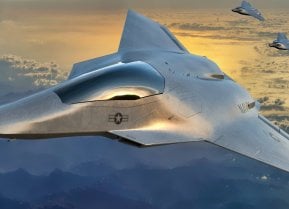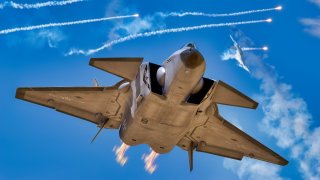China's J-20 Fighter Has 1 Advantage That Should 'Freak Out' the Air Force
With its ability to mass-produce the J-20, China is positioning itself as a significant rival to the U.S. in air superiority.
Summary: China's Chengdu J-20 "Mighty Dragon" is a fifth-generation fighter aimed at challenging U.S. and Russian dominance in the skies.
-While the J-20 may not match the stealth capabilities of the U.S. F-22 Raptor, its larger radar cross-section allows for more internal weapon storage, and recent upgrades, such as Chinese-built WS-15 engines, enable true supercruise capabilities.
-China's focus on network-centric warfare and the integration of artificial intelligence makes the J-20 a serious contender in modern aerial combat.
Key Point: With its ability to mass-produce the J-20, China is positioning itself as a significant rival to the U.S. in air superiority.
China’s J-20 Fighter is a Serious Plane..and Can Be Mass Produced
China, Russia, and the United States are all jockeying for dominance. China and Russia are friends for now. But neither would be content to let the other have military supremacy in key technological domains such as the fifth-generation warplane.
China strives to become the dominant player in this arena. While it is unlikely that their Chengdu J-20 Mighty Dragon can compete with the U.S. Air Force’s legendary F-22 Raptor, the J-20 is comparable to the Russian equivalent, and it might be on par with America’s F-35 Lightning II.
The J-20 has supercruise and advanced avionics.
Since its initial flight in 2011, this bird has been technologically enhanced, making it the ultimate symbol of the kind of modern, technological force that Beijing dreams their air force can be in the 21st century.
Comparable to the F-22?
Most analysts believe the J-20 is not comparable to either the American F-22 or the Russian Su-35 when it comes to stealth capabilities, a key feature of any fifth-generation warplane. Yet its larger radar cross-section means that it can carry more weapons internally than its American or Russian rivals.
This is, of course, a key advantage if the J-20 ever finds itself in combat against such jets.
The J-20 was initially powered by Russian engines. Finally, though, the Chinese were able to work out their own substitutes, and this bird is now powered by two Chinese-built WS-15 engines. These indigenously produced powerhouses approach the performance of the F-22 Raptor’s F119 engine, according to the writers over at Breaking Defense. This author is inclined to agree with that assessment, especially because the WS-15 lends a significant thrust-to-weight ratio to the J-20, thereby allowing for real supercruise capabilities. (That’s the ability to maintain supersonic speeds for protracted periods.) What’s more, the embrace of the WS-15 makes China less dependent on foreign engines.
If a major war erupts between China and others, not being dependent on foreign engines will be key to helping Beijing maintain the integrity of its defense-industrial base.
China claims its J-20 not only has supercruise capabilities that rival anything the Americans or Russians have in their arsenals, but they are also keen on making the J-20 compatible with the ongoing revolutions in unmanned aerial vehicles and artificial intelligence.
Under the guise of data fusion, the J-20 has been upgraded to have a better role in network-centric warfare, which is the defining trait of all future combat.
China Can Outproduce the Americans
China is a mass-production manufacturing superpower. Much more so than the United States or any of its Western allies. There is evidence to suggest China has increased production of the J-20 as a means of outpacing the Americans, who have a limited number of F-22s and F-35s. There’s even some hint China might sell a version of the J-20 to foreign powers as a way of clawing back American and Russian dominance of the advanced arms industry.
While China is already developing its own sixth-generation warplane as an offset to the sixth-generation planes being developed by the United States and Europe, there is growing concern that China might be upgrading its next round of J-20s to be friendlier to sixth-generation concepts, such as marrying this manned craft to unmanned systems.

Anyone who doubts the J-20 is a worthy challenger to U.S. and Russian fifth-generation warplanes ought to simply look at the way that China is investing in the aircraft. If it were bad, Beijing would quietly phase out the model and move on. But they did not.
The last thing any American should want is for its Air Force to engage in a fair fight. China’s J-20 makes any fight with the Americans far fairer than what Washington should be comfortable with.
Author Experience and Expertise: Brandon J. Weichert
Brandon J. Weichert, a National Interest national security analyst, is a former Congressional staffer and geopolitical analyst who is a contributor at The Washington Times, the Asia Times, and The-Pipeline. He is the author of Winning Space: How America Remains a Superpower, Biohacked: China’s Race to Control Life, and The Shadow War: Iran’s Quest for Supremacy. His next book, A Disaster of Our Own Making: How the West Lost Ukraine, is due October 22 from Encounter Books. Weichert can be followed via Twitter @WeTheBrandon.
All images are Creative Commons or Shutterstock.
From the Vault
Russia Freaked Out: Why the U.S. Navy 'Unretired' the Iowa-Class Battleships
Battleship vs. Battlecruiser: Iowa-Class vs. Russia's Kirov-Class (Who Wins?)


